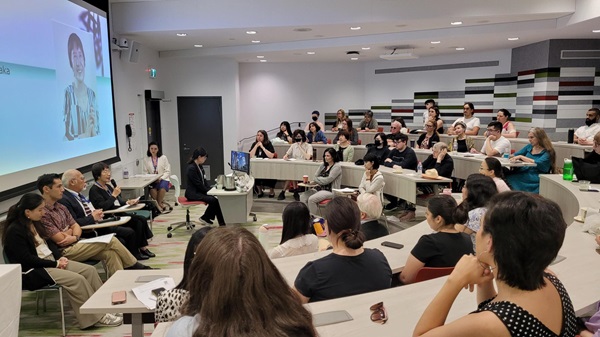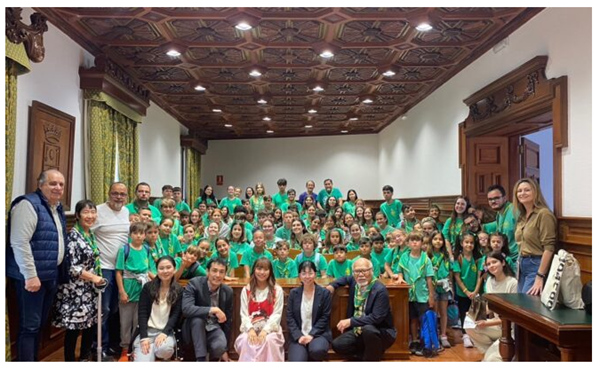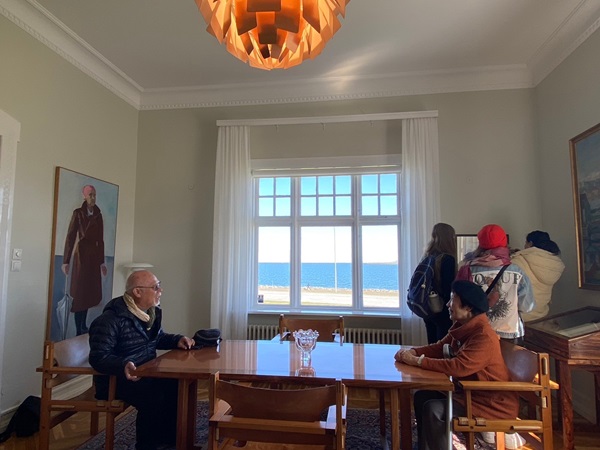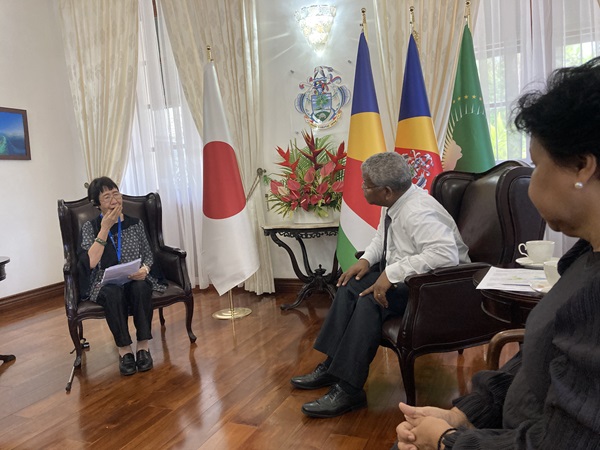
Testimony Session at Simon Fraser University in Vancouver, Canada (July 8, 2024)
News
Peace Boat’s 117th Voyage Advocates for a Nuclear-Free World at 12 Ports of Call
As part of its mission to raise global awareness of the inhumanity of nuclear weapons, the Japan-based international NGO Peace Boat has coordinated Global Voyages for a Nuclear Free World: Peace Boat Hibakusha Project since 2008. To date, over 170 Hibakusha (survivors of the atomic bombings of Hiroshima and Nagasaki) have participated in this project, travelling around the world to call for a nuclear-free future.
In April 2024, Peace Boat’s 117th voyage set sail on a global journey, marking the resumption of the project after the pandemic under the theme of “Global Voyage for a Nuclear-Free World: Beyond Borders and Generations.
The voyage included three atomic bomb survivors (one from Hiroshima and two from Nagasaki, with one participating for part of the journey), a Downwinder (US nuclear test survivor), and two youth representatives (one from China and one with Japanese-French heritage). At 12 ports of call around the world, they were welcomed by ICAN (International Campaign to Abolish Nuclear Weapons) partners and local governments, engaging in intergenerational and cross-border exchanges.
Conveying the Reality of Nuclear Damage and Strengthening Global Momentum for Nuclear Abolition
Seychelles President Mr. Wavel Ramkalawan (centre) and Tanaka Toshiko (May 1, 2024)
The program conveyed the realities of the human consequences of the atomic bombings of Hiroshima and Nagasaki, as well as other nuclear violence in various parts of the world. Additionally, the program aimed to build momentum for nuclear abolition and raise awareness of the significance of the UN Treaty on the Prohibition of Nuclear Weapons (TPNW), which came into force in 2021.
On May 1, the delegation made a courtesy visit to Seychelles’ President Mr Wavel Ramkalawan and First Lady, Mrs Linda Ramkalawan, in Port Victoria, Seychelles. Following the testimony of Hibakusha Tanaka Toshiko, youth representative Joel Naoki Christoph expressed his respect and gratitude to Seychelles’ leadership for pursuing denuclearisation, including its ratification of the TPNW. President Ramkalawan listened intently and remarked, “Hearing directly from survivors carries great significance. I am reminded of the need to pass on a world with beautiful skies and oceans, free of nuclear weapons, to future generations.” He also reaffirmed his commitment to nuclear abolition and tackling climate change.
On May 31, in Le Havre, France—a nuclear-weapon state—the delegation was welcomed by Alban Bruneau, Mayor of Gonfreville-l’Orcher, a city actively engaged in education on the values of peace and nuclear disarmament, where a testimony session was held. Survivor testimonies were shared with middle school students, city council members, and representatives from ICAN France. Afterwards, a meeting was held with Caroline Leclercq, Le Havre’s Deputy Mayor for International Affairs, to exchange views on nuclear policy. Jean-Marie Collin of ICAN France encouraged the city to sign the ICAN Cities Appeal in support of the TPNW.
On June 23, in Cartagena, Colombia, a testimony session was held for local residents at an event organised by the Colombian Campaign to Ban Landmines. Attendees included educators who reaffirmed the importance of peace education, as well as others who expressed their willingness to support the initiatives presented in the session, such as Hibakusha Ogawa Tadayoshi and his granddaughter Nagato Mone, who introduced their “Never Forget Project.”* Afterwards, a discussion was held with disarmament officials from the Ministry of Foreign Affairs, where the Hibakusha directly expressed their gratitude to Colombia for signing the TPNW and urged officials to take the next step towards the ratification of the treaty.
*The “Never Forget Project” is an initiative launched by Ogawa Tadayoshi in 2009 to prevent the memory of Nagasaki’s atomic bombing from fading. It encourages people to take a photograph at exactly 11:02am on August 9—the moment of the bombing—and submit it for collective remembrance.
On June 27, in Puntarenas, Costa Rica—a country without an army—testimonies were given at a joint event hosted by the United Nations-mandated University for Peace (UPEACE) and the National Distance Education University (UNED), with participation from the country’s Vice Minister of Foreign Affairs. Speakers included Mary Dickson, a US nuclear test survivor who joined the voyage as a guest educator, as well as the Ukraine Youth Ambassadors participating in the voyage. Alongside the Vice Minister, Costa Rica’s Ambassador to Japan, NGO representatives, and students exchanged perspectives on the future of global peacebuilding.
Connecting across generations and borders

Telde City Hall, Las Palmas, Canary Islands, Spain. Hibakusha testimonies were shared with a group of 60 young people, ranging from early elementary school students to high school students. (May 25, 2024)
After learning about the nuclear policies and circumstances of various countries, Hibakusha and youth communicators adapted their presentation styles and content accordingly, broadening their perspectives on the steps needed to achieve a world without nuclear weapons.
On April 18, in Shenzhen, China, members of the Charhar Institute, an organisation connected to the Global Partnership for the Prevention of Armed Conflict (GPPAC), for which Peace Boat coordinates the Northeast Asia regional network, were invited aboad the ship for a Japan-China Citizens’ Dialogue for Peace event. Ambassador Qiu Guohong, a senior research fellow at the Institute, emphasised the importance of building mutual understanding over time to foster friendly relations between the two countries. In addition, youth participant Huang Rongyuan, originally from China, praised the courage of Hibakusha who have continued to share their stories, stating that she wished to convey the message that if nuclear weapons were ever used, it would mean the end of the world.
On May 11, in Cape Town, South Africa, an exchange meeting was held with members of the Equiano Institute, which researches artificial intelligence (AI) from various perspectives, including science and education, to promote development and peacebuilding in Africa and the Global South. When Hibakusha Tanaka Toshiko was asked, “What unique message can South Africans, who have experienced apartheid, share with the world?”, she responded, “War will happen even if we do nothing, but peace will disappear unless we continue to advocate for and build it.” This statement resonated deeply with those in attendance.
On May 25, in Las Palmas, Spain, participants visited the Hiroshima and Nagasaki Square, where the Monument to Article 9 (in reference to the “No War” clause in the Japanese Constitution) was erected in solidarity with Japan’s pacifist constitution when Spain joined NATO. A testimony session was held for a local youth group, who responded with a powerful message: “We will work together to build a future of peace and to ensure that the experiences shared with us today are never repeated.”
On June 2, in Tilbury, UK, a testimony and exchange session was held as part of a joint event co-hosted by the Campaign for Nuclear Disarmament (CND), the Quakers, and several other organisations. In the afternoon, discussions were held with members of Effective Altruism, which researches strategies for impactful social change. Approximately 300 youth from around the world participated, exploring effective ways to advance nuclear abolition.
On June 16-17, participants visited New York City, USA. The first day was spent visiting key sites related to nuclear weapons development, including sites linked to the Manhattan Project, to understand New York City’s efforts concerning nuclear weapons development, use, and disarmament. On the second day, a collaborating event titled Building a Peaceful Tomorrow for Future Generations was held in conjunction with the UN Office for Disarmament Affairs’ #Youth4Disarmament project. Global nuclear survivors—including those affected by nuclear testing in the United States and the Marshall Islands—shared their testimonies and discussed ways to engage the next generation in nuclear disarmament efforts.
On July 8, a testimony and exchange session was hosted by Mines Action Canada (MAC), one of Canada’s leading humanitarian disarmament organisations, at Simon Fraser University in Vancouver, Canada. University students, NGO representatives, officials from the Consulate-General of Japan in Vancouver, and members of the Asia Pacific Foundation of Canada attended the event.
Gaining Insights Across Different Regions

In Höfði House, Reykjavík, Iceland. (June 9, 2024)
On April 22, project members visited Singapore’s National Museum of History and the Civilian War Memorial, officially known as the Memorial to the Civilian Victims of the Japanese Occupation, which commemorates those massacred by the Japanese military during World War II. Hibakusha Tanaka Terumi reflected, “At the time, we were taught that the war was fought to liberate Singapore from British rule. Learning about Japan’s history of aggression is complex, but when conveying the reality of the atomic bombing, it is equally important to acknowledge and share what Japan has done as a perpetrator.”
On June 9, in Reykjavík, Iceland, the group visited Höfði House, a historic building where past negotiations between the United States and the Soviet Union nearly led to a proposal for a total ban on nuclear weapons. Since the visit was made together with the Ukraine Youth Ambassadors, it became an opportunity to reaffirm their commitment to nuclear disarmament and ongoing efforts to end wars today.
Bearing Witness in 12 Countries Before Returning to Yokohama
Over the course of the journey, testimonies were shared with approximately 1,000 people across 12 countries. Through exchanges with government representatives, students, and members of the public, the delegation conveyed the catastrophic consequences of nuclear weapons. They emphasised that such devastation could occur not only through deliberate use but also as a result of human error or miscalculation—plunging the world into chaos and fear.
This voyage also marked a significant achievement: thanks to the multilingual skills of the youth participants, the program was able to engage directly with local communities. Additionally, it had the opportunity to share experiences with Mary Dickson, a Global Hibakusha. On July 26, the voyage returned to Yokohama, marking the end of its journey.


